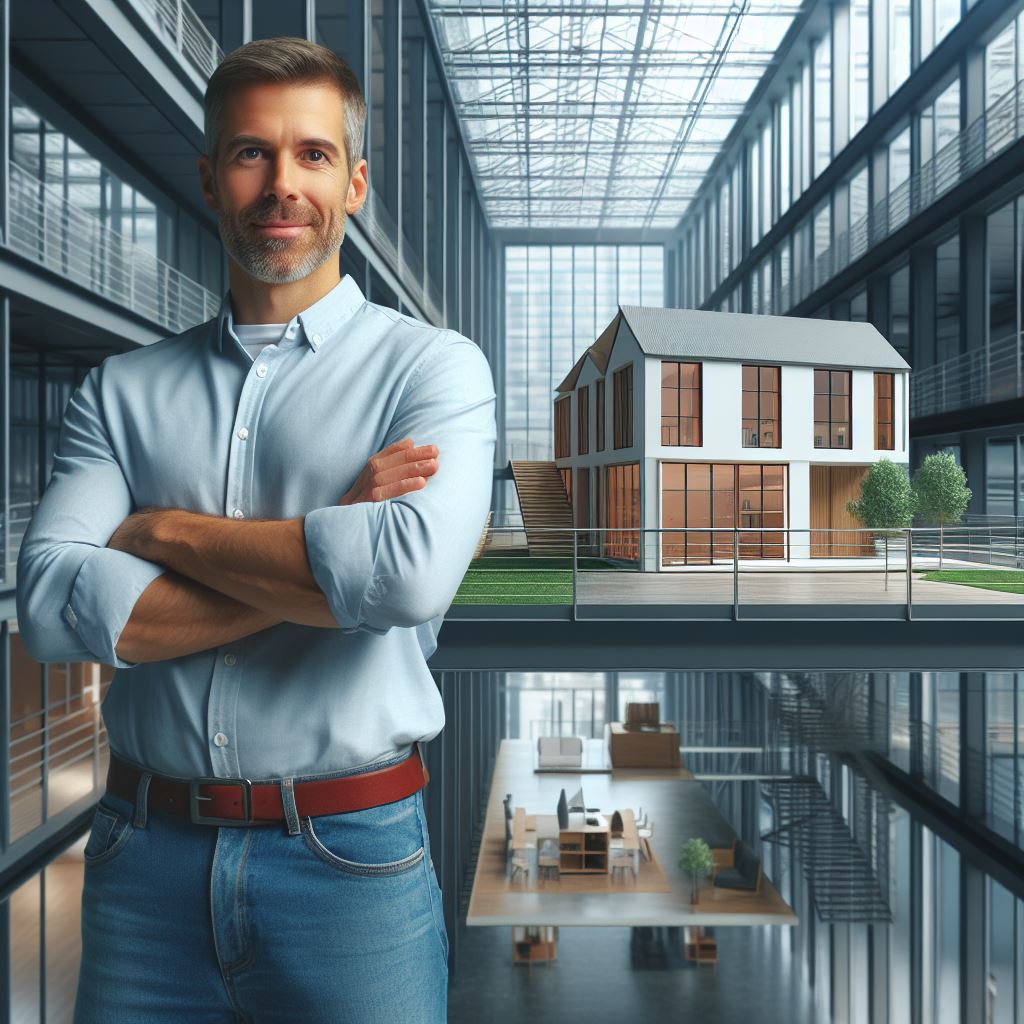Introduction
In the real estate industry, green buildings play a crucial role in promoting sustainability and energy efficiency.
Green buildings are designed to minimize their environmental impact and enhance occupant well-being, making them an essential consideration in future commercial real estate (CRE) developments.
Importance of Green Buildings in Real Estate Industry
Green buildings hold immense importance in the real estate industry due to several reasons.
Firstly, they help reduce greenhouse gas emissions by using renewable energy sources and implementing energy-efficient systems.
This not only mitigates climate change but also saves operational costs in the long run.
Furthermore, green buildings contribute to sustainability by conserving natural resources such as water and reducing waste generation.
They incorporate efficient plumbing fixtures, rainwater harvesting systems, and waste management strategies, thus minimizing the environmental footprint.
Green buildings also prioritize occupant health and well-being.
By utilizing non-toxic materials, proper ventilation systems, and abundant natural light, they create a healthier indoor environment and improve productivity and comfort for occupants.
Future Considerations in CRE Developments
The significance of considering green buildings in future CRE developments cannot be overstated.
As environmental concerns escalate and energy costs rise, demand for sustainable buildings will continue to increase.
Opting for green buildings enables developers to attract environmentally conscious tenants and investors, thereby enhancing market competitiveness.
Moreover, government regulations and incentives are favoring sustainable construction practices and energy-efficient buildings.
By incorporating green features into CRE projects, developers can comply with regulations, earn certifications, and access financial benefits.
In essence, green buildings contribute to sustainability, energy efficiency, and occupant well-being, making them indispensable in the real estate industry.
Transform Your Real Estate Decisions
Unlock personalized real estate insights crafted just for you. Get actionable advice designed to amplify your success.
Get StartedIncorporating green buildings into future CRE developments offers numerous advantages, ensuring environmental responsibility and market competitiveness.
Current Status of Green Buildings in the Commercial Real Estate Industry
In recent years, green buildings have gained significant traction in the commercial real estate industry.
With an increasing focus on sustainability and environmental consciousness, more and more developers, investors, and tenants are embracing the concept of green buildings.
Statistics on the Current Adoption of Green Building Practices
- Around 40% of commercial building owners have implemented energy efficiency measures.
- Green buildings constitute approximately 20% of the new construction market.
- The number of LEED-certified buildings has surpassed 90,000.
- ENERGY STAR certifications have been awarded to more than 30,000 buildings.
- In the United States, green buildings account for nearly $150 billion in annual GDP.
These statistics highlight the growing popularity and acceptance of green building practices in the CRE industry.
Trends in Green Building Certifications, Such as LEED and ENERGY STAR
LEED (Leadership in Energy and Environmental Design) and ENERGY STAR are two widely recognized green building certifications that have played a significant role in promoting sustainable practices.
These certifications offer a standard framework and guidelines for building design, construction, and operation.
- LEED certification provides a comprehensive rating system, evaluating various aspects of a building’s sustainability.
- ENERGY STAR certification focuses primarily on energy efficiency, aiming to reduce carbon emissions and lower utility costs.
- An increasing number of developers and building owners are pursuing these certifications to showcase their commitment to sustainability.
These certifications not only enhance a building’s marketability but also contribute to creating healthier and more efficient workspaces.
Benefits and Cost Savings Associated with Green Buildings
Green buildings offer numerous benefits to both owners and tenants, making them an attractive choice in the CRE industry.
- Reduced energy consumption leads to lower utility bills and cost savings in the long run.
- Improved indoor air quality enhances occupant health and productivity.
- Incentives such as tax credits, grants, and lower insurance premiums are often available for green building projects.
- Green buildings have higher market value and higher rental rates compared to conventional buildings.
- Corporate tenants increasingly prioritize sustainability, leading to higher tenant retention rates.
By investing in green buildings, owners can achieve a competitive edge and long-term financial benefits, while tenants can enjoy a healthier and more sustainable working environment.
In fact, green buildings have become an integral part of the commercial real estate industry.
The statistics show a growing adoption of green building practices, and certifications like LEED and ENERGY STAR have played a significant role in promoting sustainability.
The benefits and cost savings associated with green buildings make them a compelling choice for both owners and tenants.
As the industry moves forward, it is expected that green buildings will continue to dominate the CRE landscape in the coming years.
Read: 2024 Outlook: Commercial Land Values
Showcase Your Real Estate Business
Publish your company profile on our blog for just $200. Gain instant exposure and connect with a dedicated audience of real estate professionals and enthusiasts.
Publish Your ProfileTechnological advancements and innovations in green building practices
Exploration of emerging technologies in energy efficiency
Solar panels and smart building systems are emerging technologies that are revolutionizing the energy efficiency of green buildings.
These technologies harness the power of the sun and utilize advanced algorithms to optimize energy consumption.
Solar panels convert sunlight into electricity, which can be used to power the building’s lighting, heating, and cooling systems.
Smart building systems use sensors and advanced analytics to monitor and control energy usage, ensuring optimal efficiency.
Integration of green technologies in building design and operation
Green technologies are being integrated into all aspects of building design and operation to maximize sustainability and minimize environmental impact.
Architects and engineers are incorporating energy-efficient materials, such as insulation and low-E glass, into building designs.
Building automation systems are being employed to regulate lighting, heating, and cooling, based on occupancy and external conditions.
Additionally, water-saving technologies, like rainwater harvesting systems and low-flow fixtures, are being incorporated into building designs.
Role of artificial intelligence (AI) and Internet of Things (IoT) in optimizing green building performance
Artificial intelligence and the Internet of Things play a crucial role in optimizing the performance of green buildings.
AI can analyze vast amounts of data collected by IoT devices to identify patterns and make intelligent recommendations for energy efficiency improvements.
IoT devices, such as smart meters and occupancy sensors, provide real-time data on energy usage and occupancy patterns.
By leveraging this data, AI algorithms can tailor energy consumption to specific usage patterns and make real-time adjustments.
This results in improved energy efficiency, reduced operational costs, and enhanced comfort for building occupants.
In short, technological advancements and innovations in green building practices are driving the future of commercial real estate.
Emerging technologies in energy efficiency, integration of green technologies, and the role of AI and IoT are reshaping the industry.
As the demand for sustainable buildings continues to rise, these advancements will play a crucial role in meeting environmental goals and reducing carbon footprints.
It is an exciting time for the green building sector as it embraces these advancements and paves the way for a greener and more sustainable future.
Read: Waste Reduction Strategies in CRE
Regulatory and Policy Changes Impacting Green Building Practices
Overview of Government Initiatives and Regulations Promoting Green Buildings
Implementation of stricter building codes to encourage energy-efficient designs and construction practices.
Introduction of certification programs like LEED (Leadership in Energy and Environmental Design) to promote sustainable building practices.
Mandates for the use of renewable energy sources and reduction of greenhouse gas emissions in building operations.
Requirement for water conservation and management systems in green buildings to minimize wastage.
Incentives for developers to incorporate green features, such as solar panels and rainwater harvesting, into their projects.
Collaboration between government agencies and industry stakeholders to develop and endorse green building practices.
Potential Tax Incentives and Subsidies for Green Building Developers
Tax credits for green building developers who incorporate sustainable materials and energy-efficient systems.
Deductions on construction costs for implementing green building standards and practices.
Grants and subsidies provided by government bodies to offset the additional expenses associated with green building development.
Property tax abatements for buildings that meet specific sustainability criteria.
Tax incentives for green building renovations and retrofits to promote sustainable practices in existing structures.
Financial support programs to assist small-scale developers in embracing green building strategies and technologies.
Showcase Your Real Estate Business
Publish your company profile on our blog for just $200. Gain instant exposure and connect with a dedicated audience of real estate professionals and enthusiasts.
Publish Your ProfileImpact of Climate Change Policies on the Future of Green Building in CRE
Rising awareness of climate change leads to increased demand for green buildings that are resilient to extreme weather events.
Integration of climate change adaptation strategies in building design, such as flood-resistant construction and enhanced insulation.
Alignment of green building practices with climate action plans set by governing bodies to combat global warming.
Collaboration between green building experts and policymakers to create regulations that address climate change challenges.
Incorporation of building resilience measures, like passive cooling techniques and smart energy management systems, to adapt to changing environmental conditions.
Shift towards sustainable and energy-efficient building materials to reduce the carbon footprint of the construction industry.
In general, regulatory and policy changes have a significant impact on green building practices.
Government initiatives, regulations, tax incentives, and climate change policies all contribute to the growth and future of green buildings in the commercial real estate (CRE) sector.
Compliance with these regulations and leveraging available incentives can not only benefit the environment but also result in long-term cost savings for developers and building owners.
As the world seeks sustainable solutions, green buildings will play a crucial role in promoting a more sustainable future for the real estate industry.
Read: Industrial CRE Trends: What’s Next?

Market demand and responses from CRE stakeholders
Growing consumer demand for sustainable and eco-friendly buildings
The demand for sustainable and eco-friendly buildings is on the rise, driven by growing environmental consciousness among consumers.
Consumers are increasingly aware of the impact of traditional buildings on the environment and are actively seeking greener alternatives.
They recognize the importance of reducing carbon emissions and minimizing their ecological footprint.
This growing demand has led to a shift in the real estate market towards more sustainable building practices.
Developers and property owners are now focusing on incorporating eco-friendly features and technologies in their projects.
Energy-efficient systems, renewable energy sources, and green building certifications are becoming common features in new developments.
Consumers are also willing to pay a premium for sustainable buildings, further driving the market demand.
Shift in investor preferences towards green building assets
Investors, too, are recognizing the financial potential and long-term benefits of green building assets.
Green buildings offer attractive investment opportunities due to their potential for energy savings and reduced operating costs.
They also have higher market value and tend to attract tenants more easily, leading to better rental yields.
Moreover, investors are increasingly factoring in the environmental impact and sustainability of their investments.
Investing in green buildings aligns with their responsible investment goals and meets the demands of socially conscious investors.
Green building assets have proven to be resilient and have outperformed traditional buildings in terms of value appreciation.
Strategies adopted by developers, architects, and property managers to meet the demand and differentiate their offerings
- Developers, architects, and property managers are implementing various strategies to cater to the growing demand for green buildings.
- They are incorporating sustainable design principles right from the conceptualization stage.
- Using green materials, optimizing energy efficiency, and designing for natural ventilation and daylight penetration are key considerations.
- Developers are also partnering with suppliers and technology providers to source eco-friendly materials and implement energy-saving solutions.
- Architects are integrating green spaces and promoting biophilic design, which enhances occupant well-being and connectivity with nature.
- Property managers are implementing efficient waste management systems, recycling programs, and promoting sustainable lifestyles among tenants.
- By implementing these strategies, stakeholders aim to differentiate their buildings and create a competitive advantage in the market.
- They understand the importance of meeting consumer expectations and addressing environmental concerns.
Read: Hotel Sector Growth Forecast 2024
Challenges and obstacles in the widespread adoption of green buildings
Potential barriers
- High upfront costs prevent many from investing in green building practices.
- Lack of awareness about the long-term benefits of green buildings hinders widespread adoption.
- Skepticism surrounding the effectiveness of green building practices slows down their adoption.
- Misconceptions about the performance and durability of green building materials deter potential investors.
- Limited availability and access to certified green building materials pose a challenge to adoption.
- Resistance from traditional construction industry practices and resistance to change hinder adoption.
- Building codes and regulations that do not prioritize green building practices limit their adoption.
- Inadequate government incentives and subsidies for green building projects discourage adoption.
- Limited expertise and knowledge about green building practices among architects and construction professionals.
- Insufficient research and data on the long-term costs and benefits of green buildings create uncertainty.
Addressing misconceptions and skepticism surrounding green building practices
- Educating the public and professionals about the environmental and financial benefits of green buildings.
- Sharing success stories and case studies of green building projects to showcase their efficacy.
- Engaging with skeptics and addressing their concerns through open dialogue and evidence-based arguments.
- Highlighting the long-term cost savings and return on investment of green building practices.
- Partnering with industry experts and organizations to develop standardized green building performance metrics.
Solutions and initiatives to overcome challenges and accelerate the adoption of green buildings
- Implementing government incentives and subsidies for green building projects to reduce upfront costs.
- Advocating for policy changes that prioritize and mandate green building practices in construction codes.
- Investing in research and development to improve the performance and affordability of green building materials.
- Providing training and education programs to enhance the knowledge and skills of construction professionals.
- Establishing certification programs to ensure the quality and credibility of green building practices.
- Collaborating with financial institutions to develop innovative financing options for green building projects.
- Creating awareness campaigns to promote the benefits of green buildings and encourage their adoption.
- Encouraging collaboration and knowledge-sharing among industry stakeholders for best practices.
- Encouraging public-private partnerships to accelerate the implementation of large-scale green building projects.
- Continuously monitoring and evaluating the performance and impact of green buildings to drive further improvements.
Future Projections for Green Buildings in CRE by 2024
In the realm of Commercial Real Estate (CRE), the growth and market share of green buildings are projected to experience significant expansion by 2024.
Several factors contribute to this anticipated progress:
Forecast of the growth and market share of green buildings
- The demand for green buildings is expected to surge in the coming years.
- Researchers predict that green buildings will capture a sizable portion of the CRE market.
- Investors and tenants are increasingly valuing energy-efficient and sustainable structures.
- Market studies indicate a shift towards a greener approach in the CRE industry.
- The share of green buildings is estimated to grow by more than 15% within the next five years.
Anticipated advancements in green building technology
- Technological innovations will facilitate the integration of renewable energy systems in green buildings.
- Advancements in smart building technology will improve energy monitoring and efficiency.
- New construction materials will be developed, enhancing the sustainability and durability of green structures.
- Integration of Internet of Things (IoT) devices will optimize resource consumption and reduce waste.
- Emerging technologies, such as AI and machine learning, will streamline building operations and maintenance.
Projected policy changes and their impact on green building development
- Government regulations will encourage or mandate the adoption of green building practices.
- Increasing tax incentives and rebates will incentivize developers to invest in green building projects.
- Policy revisions will prioritize environmental sustainability and carbon reduction goals.
- Stricter building codes and certification requirements will drive the demand for greener buildings.
- Green building initiatives will align with global efforts to combat climate change and reduce greenhouse gas emissions.
In a nutshell, the future projections for green buildings in CRE are highly promising.
With the forecasted growth and market share expansion, advancements in technology, and anticipated policy changes, the transformation towards sustainable and energy-efficient structures is inevitable.
By 2024, green buildings will not only revolutionize the CRE industry but also contribute significantly towards a more eco-friendly and sustainable future.
Showcase Your Real Estate Business
Publish your company profile on our blog for just $200. Gain instant exposure and connect with a dedicated audience of real estate professionals and enthusiasts.
Publish Your ProfileConclusion
Green buildings play a crucial role in the CRE industry. They enhance energy efficiency, reduce environmental impact, and promote healthier indoor spaces.
The benefits extend to cost savings, increased property value, and improved occupant satisfaction.
To ensure a sustainable future, increased collaboration and commitment are needed.
The CRE industry must work together to adopt sustainable practices, including the design, construction, and operation of green buildings.
It is essential for readers to stay updated on the latest developments and opportunities in green buildings.
By staying informed, they can participate in the green movement, explore eco-friendly investment choices, and contribute to building a greener future.
Let’s join forces and make a difference in the world of real estate by embracing sustainable practices and striving for greener and healthier buildings.
Together, we can create a positive impact on the environment, economy, and human well-being.
Take action now! Commit to sustainable real estate practices, support green building initiatives, and encourage others to do the same.
Let us shape the future of the CRE industry, one green building at a time.




